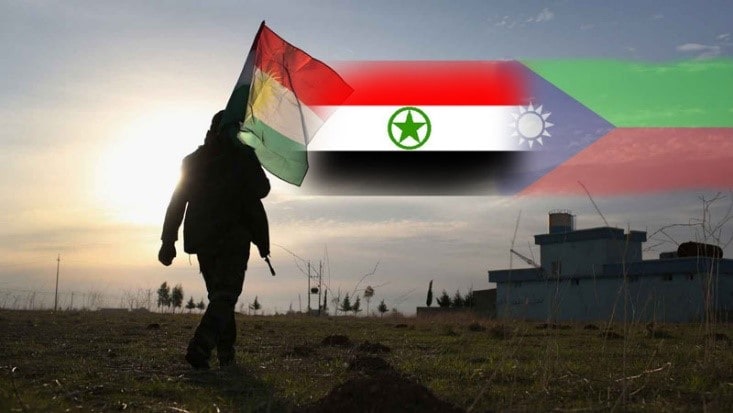Understanding Iran's periphery and the grievances of its ethnic groups is essential to shaping a strategy for the collapse of the Islamic republic of Iran.
Contemporary Iran, like medieval Iran, is not a country but a heterogeneous, multinational, and multilingual empire. In Iran, Persians make up half the country's population, while the other half comprises minorities, which maintain a strong ethnic identity that distinguishes them from Persians.
It is worth noting that some 75 languages (e.g., Turkic, Kurdish, Balochi, Arabic, and Caspian languages) are spoken in Iran. As noted by the Iranian scholar Eliz Sanasarian, "if language is utilized as the main distinguishing feature of ethnicity, Persian, despite being the official language, is the mother tongue of barely half of the population of Iran."[1] Yet many of these languages are becoming extinct due to the discriminatory policies implemented by the Islamic Republic of Iran – and before that, by the Pahlavi regime.

(Source: Rojikurd.net)
Population Data
Iran's population is estimated at around 89,000,000, roughly half of whom are ethnic Persians that predominantly live in central Iran, the rest being Kurds, Balochs, Azeris, Arab Ahwazis, Turkmen, Lurs, Gilakis, Mazandaranis, etc. Hence, it can be stated that non-Persian ethnic minorities make up 40 to 50 percent of Iran's population. It is worth noting that the Islamic republic of Iran has deliberately not collected data on ethnic groups for decades, making it difficult to accurately assess the country's ethnic composition. Yet, in 2018, the Washington Kurdish Institute estimated that Kurds constitute 12-15 percent of the Iranian population.[2]
The Arab Ahwazi also denounced the deliberate demographic changes in their region that were put in place by the Islamic Republic Of Iran, and before that by the Pahlavi regime. "The population of Ahwaz is about 12 million people, 99 percent of the population was Arab, but this percentage has changed. This is due to the Iranian government's policy of encouraging its citizens to migrate to Ahwaz and settle there, as well as the displacement of the indigenous Arabs from it. The roots of the Ahwaz people go back to many Arab tribes, including, for example but not limited to: "Bani Ka'b," "Bani Taraf," Khazraj, Kinana, Qawasim, Hammadi, Shammar, Anza, "Bani Tamim," and other tribes, Farsi is imposed as an official language for learning in the region. "It is also noted that many Ahwaz Arabs reside outside the region, either in the Gulf states or in European countries, for political or economic reasons," Ahwazstat.org reported.[3]
Concerning the Baloch population, no reliable census was conducted under the supervision of Baloch natives. However, it is estimated that there are approximately more than 10 million Balochs living under the Iranian regime. It is also worth noting that there are more than 50 million Balochs under Pakistani rule. As in the case of the Kurds, whose population, despite being divided into four countries (Turkey, Syria, Iraq, and Iran), maintains a common identity and a shared cause, Balochs, in Iran and Pakistan, support each other and their fight to free themselves of the oppressive rule of the Islamic Republic of Iran and Pakistan.
A Strategic Outpost For The West
Although the successive regimes in Iran have succeeded in tackling ethnic uprisings, they have lost the ideological and political war against non-Persian ethnic groups.
Since the foundation of modern Iran in 1925, there has been little support for the central government or its ideology and politics in the ethnic regions of the country. The state has therefore viewed non-Persian ethnic groups and their political struggle for survival as an existential threat to its integrity. Nevertheless, through their growing opposition to the regime's policies and systematic discrimination, ethnic groups across Iran have become a crucial force turning ethnic mobilization into an important space of resistance and movement for political change in the country.
It is worth noting that there is considerable solidarity between non-Persian ethnic groups seeking greater political and cultural rights. They have a common enemy that persecutes, imprisons, executes them, deprive them of their natural resources, and even denies non-Persian students the right to education in their mother tongues. This has led them to view their fight for self-determination as a common struggle for national liberation against the Islamic Republic of Iran. This shared struggle unites these ethnic groups.[4]
There is a need for an organization outside Iran designed to unite the Iranian opposition around a common platform. There are attempts by these groups to unite, but sustaining a powerful, unified front against Iranian regime would require substantial external political support. To support these ethnic groups signifies protecting Western strategic interests not only in the Middle East. China has eyed Balochistan, for example, for its Gwadar port, in order to push the China-Pakistan Economic Corridor (CPEC) as part their Belt and Road Initiative. If supported by the West, Balochistan can be a strategic outpost not only to counter the Islamic Republic of Iran but also China's hegemonic ambitions.
*Himdad Mustafa is a Kurdish scholar and expert on Kurdish, Iranian and Turkish affairs.
[1] Eliz Sanasarian, Religious Minorities in Iran. Cambridge University Press, 2000.
[2] Dckurd.org/2018/10/01/the-kurds-an-easy-meal-for-the-iranian-regime, October 2, 2018.
[3] Ahwazstat.org/en/ahwaz-a-systematic-iranian-policy-to-obliterate-the-arab-identity-2, April 7, 2022.
[4] Balochwarna.com/2023/04/23/free-balochistan-movement-activists-express-solidarity-with-ahwazi-arabs-and-kurds/, April 23, 2023.




